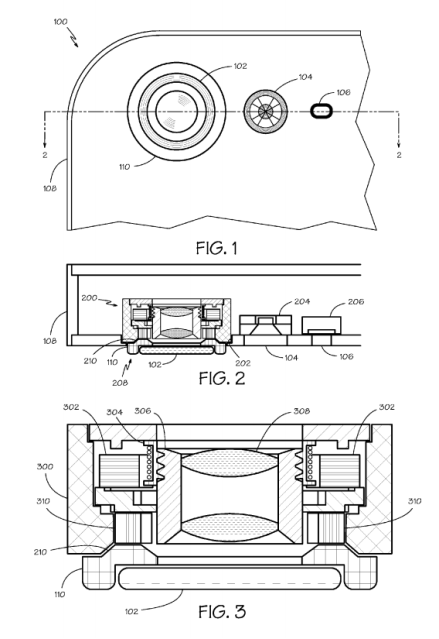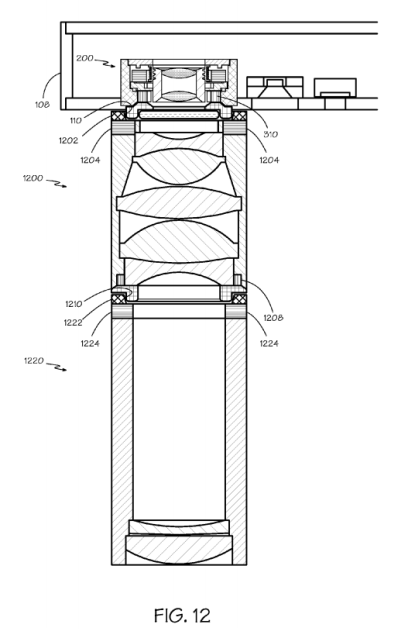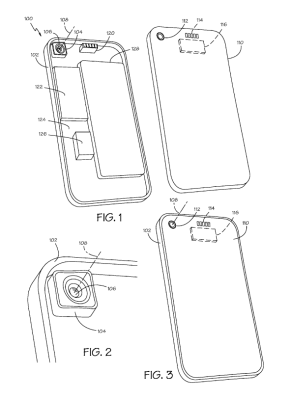Apple has been granted two patents relating to ways it might look to extend/augment the built in camera lenses on its mobile devices in future (via AppleInsider).
The two patents, granted to Cupertino by the U.S. Patent and Trademark Office, are: Patent No. 8,638,369 (pictured above) for a “Back panel for a portable electronic device with different camera lens options” and Patent No. 8,639,106 for a “Magnetic add-on lenses with alignment ridge” (pictured below).

The back panel patent was filed in December 2010, and credits Richard Tsai, now a senior camera engingeer at Apple, as its inventor.
The magnetic add-on lens patent was filed in December 2012, and credits Jeffrey Nathan Gleason and Misha Scepanovic as inventors — the latter now an optical engineer at Apple, according to LinkedIn.
The back panel patent describes a system for extending the camera on a portable electronic device by supporting replaceable lenses — using an imaging subsystem and a removable panel containing optical components.
So, in other words, a swappable back plate that lets the user choose a different type of hardware lens — such as a wide-angle lens — or to support image stablisation and zoom. The patent even talks about the possibility for adding a mechanical shutter or stroboscopic flash via the hardware add-on.
From the patent summary:
A portable electronic device includes a digital imaging subsystem with a lens having an optical axis. A case encloses and supports the digital imaging subsystem in a first defined positional relationship to the case. A removable panel is coupled to the case and held in a second defined positional relationship to the case that covers the digital imaging subsystem without the removable panel being directly connected to the digital imaging subsystem. An optical component is supported by the removable panel such that the optical component is aligned with the optical axis and alters optical characteristics of the digital imaging subsystem. The device may include a power supply and an electronic control system coupled to the digital imaging subsystem and the power supply enclosed in and supported by the case. Electrical connectors may couple the power supply and the electronic control system to an electrical component on the removable panel.
The second, more recent patent, also describes a way to extend the camera performance of a thin “multifunctional” portable electronics device (which, once again, in the patent drawings resembles an iPhone) via optical hardware add-ons — but this time utilising magnets as the mechanism for attaching and detaching additional speciality lenses.
Discussing the rational for extending the camera in this way, the patent notes:
The optics for providing a telephoto lens and other specialty lenses require a certain length for their optical path, which often is unavailable within a small device. Further, users generally want to use a specialty lens intermittently. Therefore it is desirable to be able to change the lenses that are in the optical path to provide specialty optics when desired.
Apple is not the first mobile maker to look at hardware add-ons for extending smartphone camera optics. Last fall Sony announced the QX10 and QX100 camera lenses, for instance, for clipping onto a smartphone so you can take higher quality pictures — which is exactly the sort of scenario this patent envisages. As better cameraphone optics have steadily eroded the need for the average person to carry a separate point and shoot camera, so the next wave of mobiles looks set on getting seriously pro — and attacking the USP of DLSR devices. So this looks like more bad news for camera makers.
Apple’s 106 patent includes several drawings mocking up potential add-on lenses — including a telephoto lens in a horizontally-configured arrangement to save space, and multi-lens configuration additions which could include moveable elements such as the one pictured below:

As for the magnetic angle, Apple is a long-standing fan of magnetic fixture, having used magnets to ease the plugging and unplugging of power cords on its portable laptops for years, for instance, and also using magnets on the iPad as an anchor for its smart cover cases.
The newly granted patent notes:
A plurality of magnets are arranged on the camera module adjacent to the alignment feature to retain a detachable lens on the housing and engage the alignment feature to align the detachable lens with the optical axis. The plurality of magnets may be further arranged to minimize interference with the voice coil motor and movement of the moveable element of the lens assembly.
